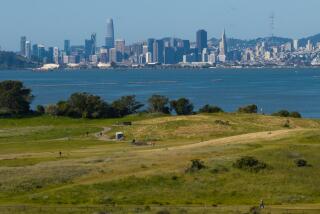Loophole in Bright-Light Ban : Welk Village Lights to Dim Observatory
- Share via
Discovery of a gaping loophole in a county light pollution ordinance designed to protect astronomical research frustrated attempts by county supervisors Wednesday to prevent the installation of high-pressure sodium street lights at Lawrence Welk Village near Escondido.
Kathy Lehtola of the county’s Public Works Department told the Board of Supervisors that the loophole in the ordinance it approved last year “would allow private street lighting systems owned and operated by San Diego Gas & Electric Co. to escape the intent of the ordinance . . . that all street lighting, after Jan. 19, 1985, should be low-pressure sodium.”
The ordinance was passed late last year after intense lobbying by astronomers concerned about preserving the darkness of the sky for their research at observatories on Mt. Palomar and Mt. Laguna.
Lehtola said SDG&E;, as a public utility, “does not need county approval for the work it does, so lighting systems it owns may not be subject to the ordinance.” Lehtola said SDG&E; had voluntarily complied with the ordinance until it encountered opposition from officials at Lawrence Welk, who did not want the yellow-hued, low-pressure street lights installed on their private streets.
The supervisors decided they had no way to block installation of the high-pressure street lights for a new mobile home park at the large retirement community north of Escondido, which is close to the Palomar Observatory. But they angrily ordered the drafting of an amendment to the ordinance to close the loophole, which they expect to approve within two weeks. And they said they would consider purchasing street lights owned by SDG&E; in the unincorporated area (a move recently undertaken by the City of San Diego) to switch off similar problems.
“This totally subverts the intention of the ordinance,” said Supervisor George Bailey. “It’s wrong for those lights to go in there, and it never should have come to this. I’m not proud of our staff for not catching these loopholes.”
Officials for Palomar Observatory, whose astronomers helped draft the outdoor lighting ordinance, shared the blame for the loophole.
The county staff “had no basis for denying” Lawrence Welk Village’s request, said Paul Peterson, an attorney for the California Institute of Technology, which owns Palomar Observatory. “The glitch in the ordinance is something we should have caught,” he said.
Peterson added that “at least 50” large private developments in the unincorporated area are exempt from the ordinance until the loophole is closed.
Peterson said he had hoped Lawrence Welk Village would voluntarily install the low-pressure lights “to be good citizens.” He said it was “unfortunate that Lawrence Welk is proceeding” with installation of the high-pressure lights.
Greg York, a planning consultant for the village, retorted that Palomar astronomers had “dumped on the Welk organization.” He said the high-pressure sodium street lights to be installed “are the same lighting standard we have elsewhere throughout the park.”
Supervisor Paul Eckert had sided with Lawrence Welk Village even before discovery of the loophole made its application for a waiver to the lighting ordinance a moot point. “You’d think the world was coming to an end up there (at Palomar),” he said.
In an earlier letter to the board, Eckert said installation of low-pressure lights at Welk Village “would conflict with the rural ambiance of the area because the heads of many of the lights would be higher than many of the low coastal oaks.” (Low-pressure sodium street lights typically are placed on higher poles than the high-pressure variety.)
Eckert also said that “conformity of the lighting system adds to the attractiveness of the area,” which is visited by many tourists.
Robert Dias, a spokesman for Lawrence Welk Village, said his firm opposed low-pressure sodium lights because of their poor light quality. The lights “would be very difficult for our older residents, (who) enjoy being able to walk around the village at night,” he said. “The color the eye sees creates a definition problem for elderly people.”
More to Read
Sign up for Essential California
The most important California stories and recommendations in your inbox every morning.
You may occasionally receive promotional content from the Los Angeles Times.










